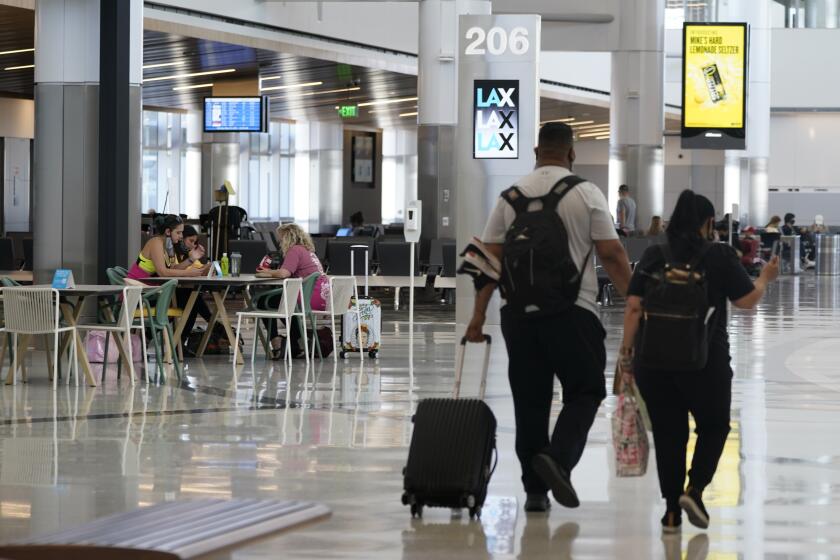San Bernardino Cool to Fast Train to Vegas
- Share via
SAN BERNARDINO — Las Vegas officials and other advocates of a high-speed train that would link the gambling resort and Southern California brought their sales pitch to San Bernardino this week, near the proposed western terminus of the line, and found the reception very chilly.
County and city leaders told a Las Vegas delegation, headed by Mayor Bill Briare, that the proposed $5-billion, 250-m.p.h. train would create serious traffic and air pollution problems in the area surrounding the proposed Ontario terminal and would transfer hundreds of millions of Southern California dollars to Las Vegas every year, with small return.
Briare, City Manager Ashley Hall and other Las Vegas officials came to Southern California to tout the results of a two-year, $1.25-million study that concluded that the high-speed train would be financially and technologically feasible.
But they ran into strenuous objections when they presented the findings Wednesday to the San Bernardino Assn. of Governments, a planning group that includes elected city and county officials.
Three of the five county supervisors attended the meeting and all three said, in separate interviews, that they opposed the train.
“I see no advantage in this project for our region,” said newly elected Supervisor Larry Walker, former mayor of Chino.
Supervisor Barbara Cram Riordan said she is “very enthusiastic about this technology but not about this route.”
Riordan said she would support high-speed train service between San Bernardino County and downtown Los Angeles or Orange County but not between Ontario and Las Vegas.
Jon Mikels, another newly elected supervisor, said the proposed 60-acre Ontario terminal, with its 12,000-to-21,000-car parking lot, would create severe air pollution and traffic congestion problems.
Robert E. Parsons, chief consultant to Las Vegas on the project, argued that the super-speed train would reduce the heavy traffic on Interstate 15 between Ontario and Las Vegas and would improve air quality by luring travelers from their cars to the train.
Parsons said the Ontario-Las Vegas train could be the beginning of a network of high-speed trains that would help to solve California’s growing traffic congestion and air quality problems.
“You people are going to have to start thinking about getting along without your cars,” he said.
But Mikels and other local elected officials replied that the congestion and pollution problems created by the Ontario terminal would be worse than any benefit the train might provide.
A report prepared by Wes McDaniel, executive director of the county association of governments, said the train would create a “huge net consumer spending imbalance to Southern California.”
By the year 2010, when the train would have been operating for 15 years, spending by riders in the Las Vegas area would be $554 million a year more than spending by riders that the train brings to Southern California, according to McDaniel’s report.
Victorville City Councilwoman Peggy Sartor said “people in the desert are concerned” because the high-speed train would not stop in Barstow or Victorville.
‘You Just Lost Us’
“The ground rules are, ‘If you want a terminal, you pay for it,’ ” Parsons said, adding that there did not appear to be enough potential riders in the two desert cities to justify stops.
“I think you just lost us (as supporters),” Sartor replied.
The McDaniel report also noted that the Las Vegas feasibility study rests on key findings that some might question, including the high ridership predicted for the train and the reliability of the West German “magnetic levitation” technology that probably would be employed but is not in operation anywhere else in the world.
Another finding open to challenge, the report said, is the willingness of the West Germans or another developer of the technology to put up several billion dollars to build the system, the step that is called for in the complicated financing scheme for the train.
The Las Vegas delegation did find some support during its two-day visit.
Assemblyman Gerald R. Eaves (D-Rialto), sitting in on the Wednesday meeting, said, “I like the idea of being on the cutting edge of technology,” and added, “We’ll do whatever we can” at the state level to facilitate the project.
The day before, members of the Ontario Chamber of Commerce expressed enthusiasm for the train, which chamber Executive Director Brent Hunter said “might put Ontario on the map and convince people we’re not a Canadian province.”
Hunter said that if just 2% of the non-Californians who visit Las Vegas every year rode the train to Ontario for a day, “it would fill every hotel and motel in the area.”
More to Read
Sign up for Essential California
The most important California stories and recommendations in your inbox every morning.
You may occasionally receive promotional content from the Los Angeles Times.










